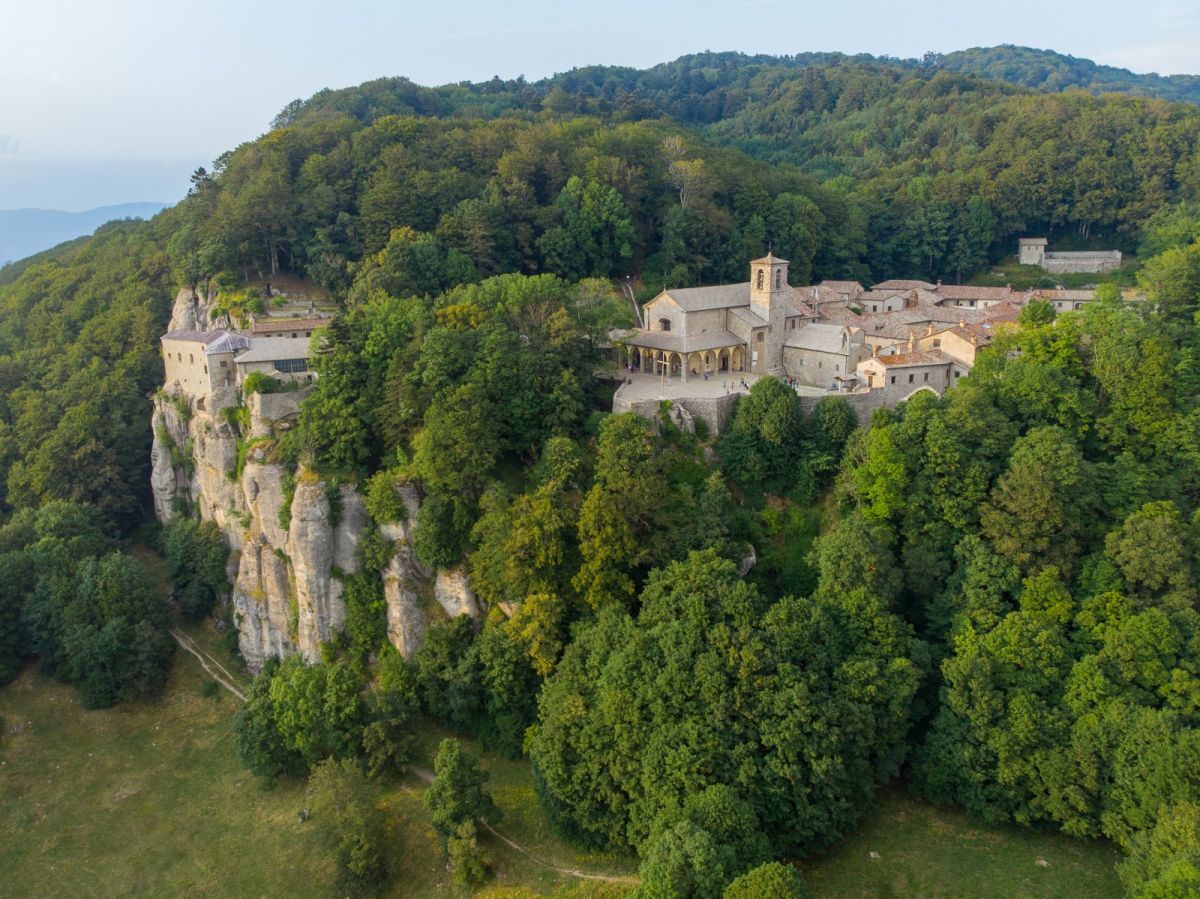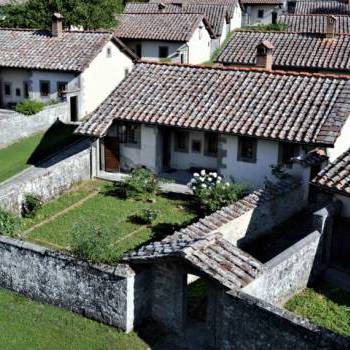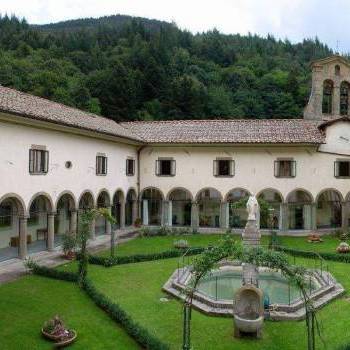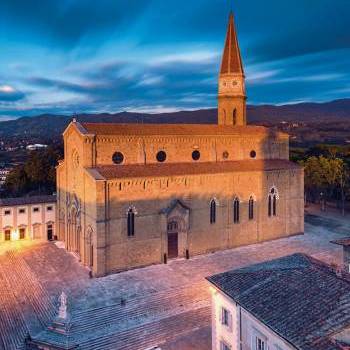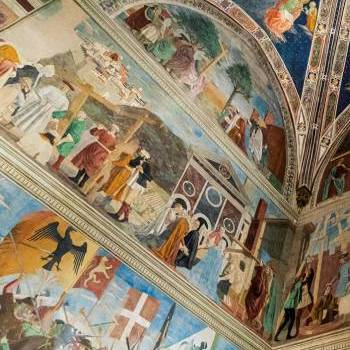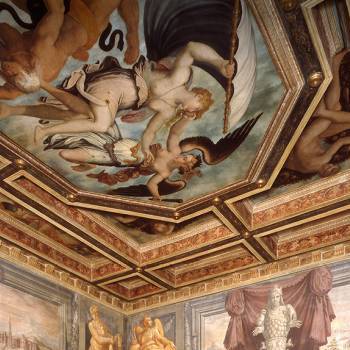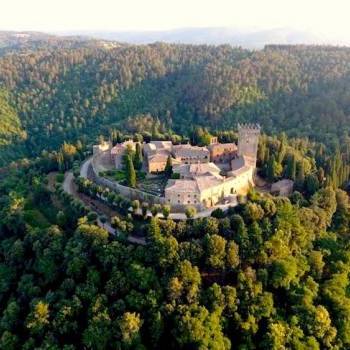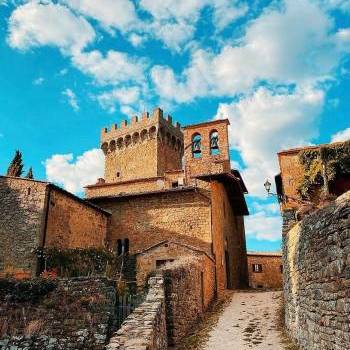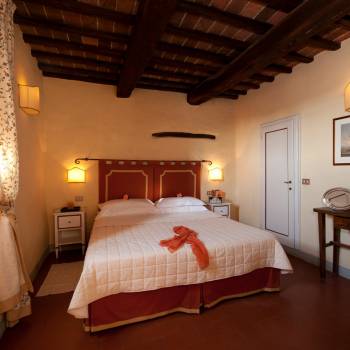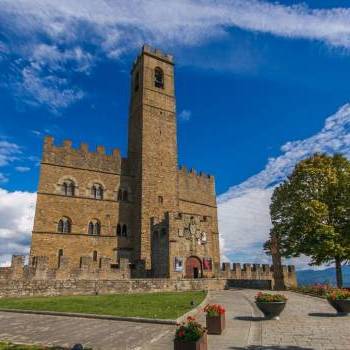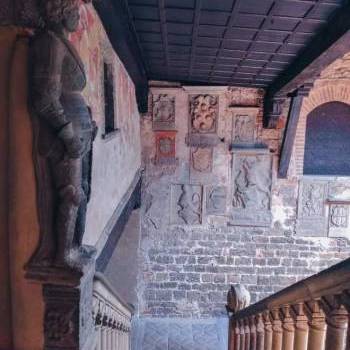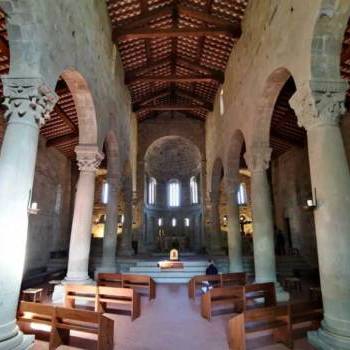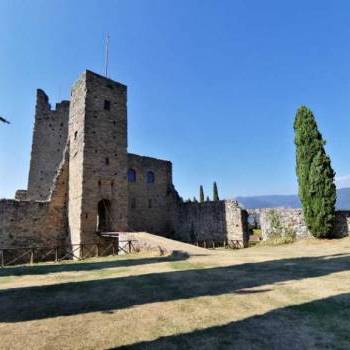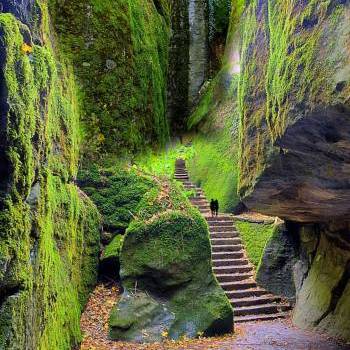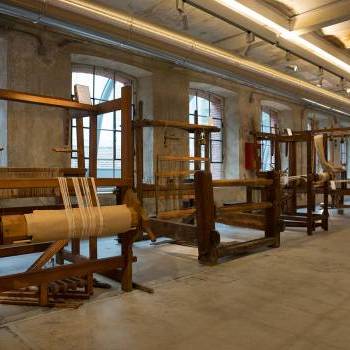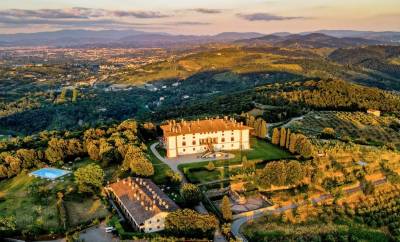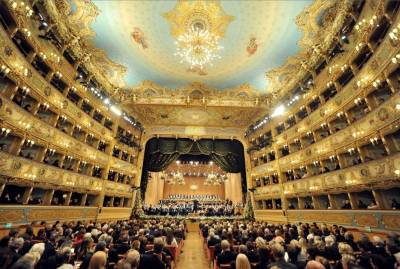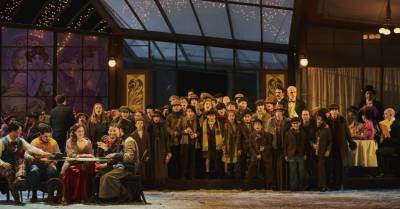
Unusual Tuscany: Casentino
Explore a wonderful little-known Tuscany area
5 days / 4 nights - Travel Idea
Suggested time: Spring/Autumn
A journey through time exploring a dream Tuscany. Castles, villages, artistic jewels and food tastings among the places where Dante stayed and set some of the Divine Comedy’s Cantos.
The itinerary takes us to the heart of the Casentino Forests, to timeless places where we can admire artistic beauties rich in spirituality, set in breathtaking views to immerse ourselves in nature with Forest Therapy and a private concert of medieval music.
The journey starts from the Castle of Gargonza, a magnificent thirteenth-century fortified village and widespread residence restored with full respect for the memory of the past, continues to discover Poppi and its castle with splendid fourteenth-century frescoes.
We will discover places immersed in spirituality, such as Camaldoli with its Monastery and Hermitage, the Castello di Romena, the Pieve di San Pietro and the Santuario di La Verna, a sacred place where San Francesco di Assisi received the Stigmata; enriched by an exclusive concert of medieval music.
There will be no shortage of visits to medieval villages with particular museums such as Stia and its Museo dell'Arte della Lana, and the beautiful Arezzo with its many art treasures and the birthplace of Giorgio Vasari: painter, architect and first art historian of the modern age.
To conclude the tour in the most beautiful way: a morning of relaxation with Forest Therapy and finally the tasting of typical local products.
Block notes:
- A charming stay - Inside Castello di Gargonza and its walled village
- Medieval Music - Private concert inside Castello di Gargonza
- Art and Spirituality - Mystical treasures such as monasteries, hermitages, sanctuaries, castles, enchanted villages and the beautiful Arezzo
- Nature - Forest Therapy in the woods
Proposal for an indicative itinerary. The tour can be modified and adapted to any requests for further insights on topics chosen by the custom.
Day 1 - Arrival at Castello di Gargonza
Arrival at Castello di Gargonza - Dimora Storica (30 km from Arezzo) by own means.
Sleeping in a fortified village in Tuscany is truly a magical and unforgettable experience. The rooms have maintained the charm and atmosphere of the peasant community that once inhabited Gargonza but are equipped with every comfort and luxury. Each room, suite or apartment is located in a different building in the Borgo and all accommodations have their own story to tell.
In the afternoon: a walk in the fortified Borgo of Gargonza.
The Castello di Gargonza, one of the most evocative castles in Arezzo, is a fortified village from the 13th century where Dante spent a few days of his exile, located in the splendid Val di Chiana. In the 15th century, the Castello di Gargonza was known as the village of a community dedicated to the care of the woods and the production of wool and subsequently, in the mid-17th century, an organized farm was born with sharecropping land over a fairly large area of nine hundred hectares. Following the rural exodus, his sharecropping activity ceased. In the first half of the twentieth century the Castle was abandoned by the community and around 1970, Roberto Guicciardini Corsi Salviati, owner of Gargonza, dedicated himself to its restoration, fully respecting the memory of the past to bring one of the most beautiful villages in Tuscany back to daily life.
Welcome drink in the orangery garden and dinner.
La Torre di Gargonza is the restaurant located right outside the village walls and was created from what was once the shed for agricultural machinery and carpentry. In summer it is possible to eat outside in the courtyard and in the panoramic room which enjoys a beautiful view overlooking the majestic forest. The restaurant's cuisine is authentic, typical Tuscan, made of simple and genuine ingredients personally chosen from the seasonal offerings.
Day 2 - Poppi / Camaldoli
Breakfast.
Departure by bus to visit Poppi and Castello dei Conti Guidi, emblem of the town and of the whole Casentino, Campaldino, place of the famous battle.
Poppi is in one of the most beautiful valleys in Tuscany, in the Casentino. The Castle of the Guidi Counts is a 13th century work, characterized by a mullioned façade, in the center of which stands a high tower, and surrounded by walls with Guelph battlements and a large moat. It houses a museum and a library, full of 25 thousand ancient volumes, manuscripts and incunabula, and also the modern library. The most important element is the chapel of the Guidi Counts with a cycle of fourteenth-century frescoes attributed to Taddeo Gaddi, a pupil of Giotto.
Lunch in a typical restaurant.
In the afternoon arrival to Camaldoli and visit of the monastery and the hermitage.
Camaldoli, ounded a thousand years ago by San Romualdo is a community of Benedictine monks, immersed in the peace of the forest, representing the two fundamental dimensions of the monastic experience: solitude and communion.
The Monastery is the place in which the monks, despite also experiencing solitude, experience fraternal life and communion, also thanks to the hospitality of guests: in the spaces of the Monastery and in those of the Guest House.
The structure of the Sacred Hermitage is inspired by the spirituality of the desert fathers: monks who retired from the first centuries of Christianity to live a daily life interwoven with prayer, silence, solitude, work, and staying in a cell.
Return to the hotel and dinner.
Day 3 - Romena (Pieve di San Pietro) / Stia
Breakfast.
Departure by bus to visit Romena with the magnificent Romanesque parish church and its imposing castle, it is one of the most beautiful and significant places in the Casentino.
The Pieve di San Pietro, declared a National Monument, is a magnificent example of Romanesque architecture. It was built at the time of the famine of 1152 by "Albericus Plebanus", as can be read engraved on a capital inside. It was built on a pre-existing 8th century church, the remains of which are visible under the floor. Its current façade is not the original one, and the bell tower also collapsed during the earthquake of 1729, and was lowered when the cell was rebuilt. The interior has three naves, divided by ten columns with phytomorphic, zoomorphic and anthropomorphic capitals. The biblical scenes are accompanied by motifs and symbols relating to the rites of fertility and harvest propitiation of pagan origin.
A short distance from the Castello di Romena, an imposing medieval fortress whose existence has been documented since the tenth century. It is made up of three central towers (much higher than the current ones) and three concentric fortified walls arranged on different levels. The outermost circle was punctuated by eleven quadrangular perimeter towers and equipped with four access gates, of which the Bacìa gate (current entrance to the castle) and the Gioiosa gate have been preserved today.
Lunch in restaurant.
In the afternoon visit to the village of Stia, a beautiful town born in a medieval market place.
In the Middle Ages Stia developed as a "market" of the County of Porciano and residence of the Guidi Counts. Around 1840 the municipality had a great development thanks to the processing of wool which led it to be an important production centre, in 1900 there were almost 500 workers employed in the Lanificio di Stia with the symbolic and prized product Tessuto or Panno Casentino. After the closure of the factory in 2000, the spaces of the wool mill came back to life in 2010 thanks to the creation of the Wool Art Museum. The processing cycle is told as it took place inside the wool mill, illustrated through the display of ancient textile machines, but also before industrial development: from shearing to the finalization of the fabric. Educational workshops are also held in the museum: you can experiment with some processes and learn to recognize the different textile fibers through a "tactile journey".
Dinner in the castle restaurant.
9.00 pm: Private concert inside the Castle Chappel
Medieval Music - Voice, Lute and Psaltery
Day 4 - Santuario della Verna / Arezzo
Breakfast.
Departure by bus to visit Santuario della Verna, a sacred place nestled in the heart of the Foreste Casentinesi National Park, offering breathtaking views and a profound connection with nature.
The Santuario della Verna is famous for being the place of the Stigmata of San Francesco d'Assisi in 1224. The Sanctuary Museum is composed of large fifteenth-century rooms and significant environments of the life of the ancient convent and you can admire valuable illuminated choir books from the fifteenth century, furnishings liturgical, wallpapers and paintings. Of particular note are a polychrome wooden crucifix and a ceramic bust attributed to Andrea della Robbia. A very interesting room is the one dedicated to the ancient pharmacy and the spice laboratory, in one of the most evocative places of the Sanctuary where even today it is possible to find some cosmetic, food and spirits products of organic and natural origin. The tour ends with the most characteristic environment of the museum, the common fire.
Lunch in a typical mountain inn.
In the afternoon visit to Arezzo, a journey through time, among flavours, events, stories and antiques, suggestive views and vintage charm.
Arezzo is one of the most important cities in Etruria and reached its maximum splendor between the Middle Ages and the Renaissance. The city still bears witness to this today among wonderful churches such as the Basilica of San Francesco with the cycle of frescoes "The Legend of the True Cross", Piero della Francesca's greatest work, the Cathedral where there are other works by the great Renaissance artist, Piazza Grande, the palaces, monuments and museums such as the Museum of Medieval and Modern Art and the Gaio Cilnio Mecenate Archaeological Museum, where objects and finds from the Roman and Etruscan era are exhibited. An unmissable stop is the House Museum of Giorgio Vasari: painter of mannerism, brilliant architect, fine collector of drawings, biographer and first art historian of the modern age; undisputed protagonist of the late Renaissance and one of the most influential intellectuals of his time.
Return to the hotel. Tuscan buffet dinner in the castle garden.
Day 5 - Departure
Breakfast and check-out.
Relaxing morning dedicated to the Forest Therapy: a natural method to improve health and well-being thanks to the regenerating power of the woods.
Forest Therapy produces beneficial effects if all the senses are involved, each has its role in the therapy and to stimulate them during the journey you can practice meditation and mindfulness. Spending a day completely immersed in greenery, focusing on the sounds of nature, its scents, seeking contact with trees and plants, allows all our senses to refine their perceptions. It is a very ancient practice of Japanese origin: Shinrin-yoku.
Tasting lunch in the village with wine and cheese pairing.
After lunch, farewells and individual departures.
The order of visits may vary due to operational needs without changing the content.
INCLUDED IN THE PACKAGE:
- 4 nights with breakfast
- companion
- bus 2nd, 3rd, 4th day
- welcome aperitif and historical tour of Gargonza
- guided tours as per program, entrance fees included
- 3 lunches in a restaurant including drinks
- 4 dinners in the hotel, one of which is a buffet, drinks included
- private concert
- Forest Therapy in the woods
- cheese and wine tasting lunch
- basic insurance
NOT INCLUDED IN THE PACKAGE:
- City tax
- Trip to/from Gargonza
- Extras, tips and everything that is not mentioned in the "included in the quote" section
Day 1 - Arrival at Castello di Gargonza
Arrival at Castello di Gargonza - Dimora Storica (30 km from Arezzo) by own means.
Sleeping in a fortified village in Tuscany is truly a magical and unforgettable experience. The rooms have maintained the charm and atmosphere of the peasant community that once inhabited Gargonza but are equipped with every comfort and luxury. Each room, suite or apartment is located in a different building in the Borgo and all accommodations have their own story to tell.
In the afternoon: a walk in the fortified Borgo of Gargonza.
The Castello di Gargonza, one of the most evocative castles in Arezzo, is a fortified village from the 13th century where Dante spent a few days of his exile, located in the splendid Val di Chiana. In the 15th century, the Castello di Gargonza was known as the village of a community dedicated to the care of the woods and the production of wool and subsequently, in the mid-17th century, an organized farm was born with sharecropping land over a fairly large area of nine hundred hectares. Following the rural exodus, his sharecropping activity ceased. In the first half of the twentieth century the Castle was abandoned by the community and around 1970, Roberto Guicciardini Corsi Salviati, owner of Gargonza, dedicated himself to its restoration, fully respecting the memory of the past to bring one of the most beautiful villages in Tuscany back to daily life.
Welcome drink in the orangery garden and dinner.
La Torre di Gargonza is the restaurant located right outside the village walls and was created from what was once the shed for agricultural machinery and carpentry. In summer it is possible to eat outside in the courtyard and in the panoramic room which enjoys a beautiful view overlooking the majestic forest. The restaurant's cuisine is authentic, typical Tuscan, made of simple and genuine ingredients personally chosen from the seasonal offerings.
Day 2 - Poppi / Camaldoli
Breakfast.
Departure by bus to visit Poppi and Castello dei Conti Guidi, emblem of the town and of the whole Casentino, Campaldino, place of the famous battle.
Poppi is in one of the most beautiful valleys in Tuscany, in the Casentino. The Castle of the Guidi Counts is a 13th century work, characterized by a mullioned façade, in the center of which stands a high tower, and surrounded by walls with Guelph battlements and a large moat. It houses a museum and a library, full of 25 thousand ancient volumes, manuscripts and incunabula, and also the modern library. The most important element is the chapel of the Guidi Counts with a cycle of fourteenth-century frescoes attributed to Taddeo Gaddi, a pupil of Giotto.
Lunch in a typical restaurant.
In the afternoon arrival to Camaldoli and visit of the monastery and the hermitage.
Camaldoli, ounded a thousand years ago by San Romualdo is a community of Benedictine monks, immersed in the peace of the forest, representing the two fundamental dimensions of the monastic experience: solitude and communion.
The Monastery is the place in which the monks, despite also experiencing solitude, experience fraternal life and communion, also thanks to the hospitality of guests: in the spaces of the Monastery and in those of the Guest House.
The structure of the Sacred Hermitage is inspired by the spirituality of the desert fathers: monks who retired from the first centuries of Christianity to live a daily life interwoven with prayer, silence, solitude, work, and staying in a cell.
Return to the hotel and dinner.
Day 3 - Romena (Pieve di San Pietro) / Stia
Breakfast.
Departure by bus to visit Romena with the magnificent Romanesque parish church and its imposing castle, it is one of the most beautiful and significant places in the Casentino.
The Pieve di San Pietro, declared a National Monument, is a magnificent example of Romanesque architecture. It was built at the time of the famine of 1152 by "Albericus Plebanus", as can be read engraved on a capital inside. It was built on a pre-existing 8th century church, the remains of which are visible under the floor. Its current façade is not the original one, and the bell tower also collapsed during the earthquake of 1729, and was lowered when the cell was rebuilt. The interior has three naves, divided by ten columns with phytomorphic, zoomorphic and anthropomorphic capitals. The biblical scenes are accompanied by motifs and symbols relating to the rites of fertility and harvest propitiation of pagan origin.
A short distance from the Castello di Romena, an imposing medieval fortress whose existence has been documented since the tenth century. It is made up of three central towers (much higher than the current ones) and three concentric fortified walls arranged on different levels. The outermost circle was punctuated by eleven quadrangular perimeter towers and equipped with four access gates, of which the Bacìa gate (current entrance to the castle) and the Gioiosa gate have been preserved today.
Lunch in restaurant.
In the afternoon visit to the village of Stia, a beautiful town born in a medieval market place.
In the Middle Ages Stia developed as a "market" of the County of Porciano and residence of the Guidi Counts. Around 1840 the municipality had a great development thanks to the processing of wool which led it to be an important production centre, in 1900 there were almost 500 workers employed in the Lanificio di Stia with the symbolic and prized product Tessuto or Panno Casentino. After the closure of the factory in 2000, the spaces of the wool mill came back to life in 2010 thanks to the creation of the Wool Art Museum. The processing cycle is told as it took place inside the wool mill, illustrated through the display of ancient textile machines, but also before industrial development: from shearing to the finalization of the fabric. Educational workshops are also held in the museum: you can experiment with some processes and learn to recognize the different textile fibers through a "tactile journey".
Dinner in the castle restaurant.
9.00 pm: Private concert inside the Castle Chappel
Medieval Music - Voice, Lute and Psaltery
Day 4 - Santuario della Verna / Arezzo
Breakfast.
Departure by bus to visit Santuario della Verna, a sacred place nestled in the heart of the Foreste Casentinesi National Park, offering breathtaking views and a profound connection with nature.
The Santuario della Verna is famous for being the place of the Stigmata of San Francesco d'Assisi in 1224. The Sanctuary Museum is composed of large fifteenth-century rooms and significant environments of the life of the ancient convent and you can admire valuable illuminated choir books from the fifteenth century, furnishings liturgical, wallpapers and paintings. Of particular note are a polychrome wooden crucifix and a ceramic bust attributed to Andrea della Robbia. A very interesting room is the one dedicated to the ancient pharmacy and the spice laboratory, in one of the most evocative places of the Sanctuary where even today it is possible to find some cosmetic, food and spirits products of organic and natural origin. The tour ends with the most characteristic environment of the museum, the common fire.
Lunch in a typical mountain inn.
In the afternoon visit to Arezzo, a journey through time, among flavours, events, stories and antiques, suggestive views and vintage charm.
Arezzo is one of the most important cities in Etruria and reached its maximum splendor between the Middle Ages and the Renaissance. The city still bears witness to this today among wonderful churches such as the Basilica of San Francesco with the cycle of frescoes "The Legend of the True Cross", Piero della Francesca's greatest work, the Cathedral where there are other works by the great Renaissance artist, Piazza Grande, the palaces, monuments and museums such as the Museum of Medieval and Modern Art and the Gaio Cilnio Mecenate Archaeological Museum, where objects and finds from the Roman and Etruscan era are exhibited. An unmissable stop is the House Museum of Giorgio Vasari: painter of mannerism, brilliant architect, fine collector of drawings, biographer and first art historian of the modern age; undisputed protagonist of the late Renaissance and one of the most influential intellectuals of his time.
Return to the hotel. Tuscan buffet dinner in the castle garden.
Day 5 - Departure
Breakfast and check-out.
Relaxing morning dedicated to the Forest Therapy: a natural method to improve health and well-being thanks to the regenerating power of the woods.
Forest Therapy produces beneficial effects if all the senses are involved, each has its role in the therapy and to stimulate them during the journey you can practice meditation and mindfulness. Spending a day completely immersed in greenery, focusing on the sounds of nature, its scents, seeking contact with trees and plants, allows all our senses to refine their perceptions. It is a very ancient practice of Japanese origin: Shinrin-yoku.
Tasting lunch in the village with wine and cheese pairing.
After lunch, farewells and individual departures.
The order of visits may vary due to operational needs without changing the content.
INCLUDED IN THE PACKAGE:
- 4 nights with breakfast
- companion
- bus 2nd, 3rd, 4th day
- welcome aperitif and historical tour of Gargonza
- guided tours as per program, entrance fees included
- 3 lunches in a restaurant including drinks
- 4 dinners in the hotel, one of which is a buffet, drinks included
- private concert
- Forest Therapy in the woods
- cheese and wine tasting lunch
- basic insurance
NOT INCLUDED IN THE PACKAGE:
- City tax
- Trip to/from Gargonza
- Extras, tips and everything that is not mentioned in the "included in the quote" section
